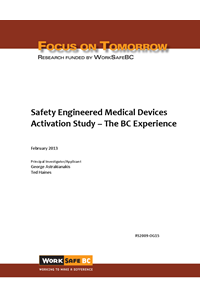Safety Engineered Medical Devices Activation Study – The B.C. Experience
Safety engineered medical devices (needles and sharps) are designed with a safety feature (e.g. shielding) to reduce the risk of accidental exposure to blood and body fluids, but their effectiveness depends on activation of the safety feature by the user. This study was aimed at understanding real-world practices around appropriate use and disposal of these devices
The study was carried out in six hospitals from three health authorities between 2009 and 2011. In the first phase of the study, 699 sharps containers were collected and examined to count the number of conventional versus safety engineered sharp devices, along with the percentage of non-activated safety devices
Based on the study's results, the researchers recommend improving consistency and availability of safety engineered devices across health care facilities and sectors, along with training for workers on use and disposal of the devices. Due to increased costs for this equipment, they suggest centralized purchasing through a government organization
| Principal Investigators: | George Astrakianakis and Ted Haines (OHSAH &McMaster University) |
| Co-investigators: | Kenneth Kamsteeg (VIHA); Yun Tang (PHSA) |
| Funding Awarded: | $186,783* (2 years) |
In partnership with the WCB of Nova Scotia

